
49
Observe that the writing protection of the SD/SDHC memory card is deactivated.
The memory card should be empty (or there still must be enough memory left). The only file format
permitted is FAT/FAT32 (no NTFS).
• The screen/DVR is now ready for operation. If no image appears after commissioning of the radio ca
-
mera (see next subchapter), the radio camera must be logged on to the screen/DVR; see chapter 11 c),
function „Pairing“.
c) Radio Camera
• First screw on the (white) aerial to the back of the radio camera. The aerial can be aligned in different
angles to improve reception.
• The enclosed assembly holder can be screwed to the bottom as well as the top of the radio camera. Both
assembly to a wall and assembly to a room ceiling is possible here.
For assembly to a room ceiling, the sun blind can be removed by pulling it off forwards.
• Attach the mounting holder with screws and possibly dowels suitable for the underground. When drilling
or screwing on, observe that no cables or lines are damaged.
Before firm assembly, first check whether the radio transmission between radio camera and
screen/DVR is proper.
Many ambience conditions have a negative influence on the range and quality of radio reception
that can be achieved. For this, observe the chapter „Range“ farther back in these operating
instructions.
Select the assembly site so that it is protected from manipulation attempts at the radio camera. The radio
camera therefore should be installed at a minimum height of 2.5 m.
We recommend to choose a site protected from precipitation/splashing water when using it out
-
doors (e.g. below a protruding roof), since drop formation of splashing water on the front screen
of the camera will cause the image to be distorted ad useless.
Point the lens of the radio camera at the desired monitoring area. Precisely adjustment can be done later,
when the radio camera image is visible on the screen/DVR.
• Place the cable, e.g., in a suitable cable duct etc. The connection socket for power supply is not water-
proof and therefore must be in a dry indoor room.
Observe that the housing (19) with the microphone in it is placed in a suitable location. Align the micro-
phone openings so that they point towards the camera monitoring area.
Fasten the housing or cable, e.g., with cable ties.
On the other side of the housing (19), there is a small, square button. This serves to log on the
radio camera to the screen/DVR („Pairing“).
Observe that this button is not pushed inadvertently. Leave some distance between the housing/
button and assembly surface.
• If the connection cables must be guided through a wall, protect the plugs from dust and dirt, e.g., with a
small plastic pocket or similar.
• Connect the low-voltage round plug of one of the two enclosed plug-in mains adapters to the correspon
-
ding socket (20) of the radio camera.
















































